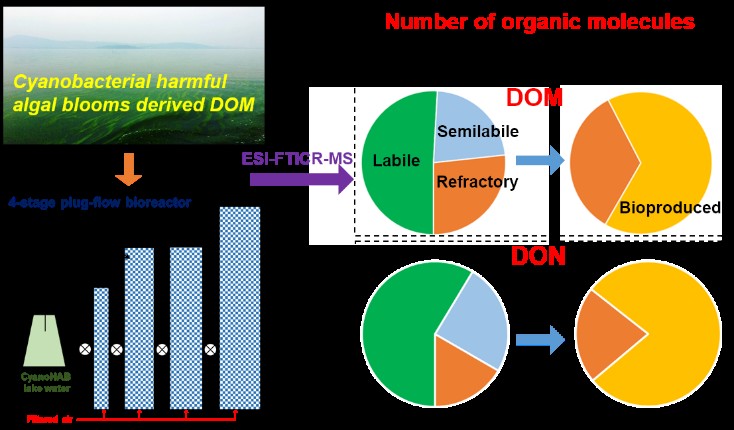Researchers Develops A New Methods to identify the bioavailability of DOM
Occurrence of cyanobacterial harmful algal blooms (CyanoHAB) in freshwater lakes induces considerable patchiness in the concentration and bioavailability of dissolved organic matter (DOM). The bioavailable DOM is currently described as a continuum with labile, semilabile, and refractory pools. These fractions can influence the biogeochemical cycles of carbon and nitrogen, the ecological succession of microbial organisms, the formation of “black water”, and the attenuation of organic contaminants in eutrophic waters.
Bioassays using indigenous microbial incubations have been frequently conducted to quantify the bioavailable fractions in DOM. This method is largely limited by the length of time required (from weeks to months) for colonization and determination. Instead, a plug-?ow bio?lm reactor was proposed as a rapid approach to identify DOM bioavailability (S?ndergaard and Worm, 2001). However, due to the unspeci?c biodegradation behavior inside the bioreactor, operators of the single-stage bioreactor may ?nd it inconvenient to analyze the microbial community structure shift in response to a succession of di?erent levels in DOM bioavailability.
The research team led by Prof. JIANG Helong from the Nanjing Institute of Geography & Limnology, Chinese Academy of Sciences (NIGLAS) developed a group of four-stage plug-?ow bioreactors as a quick and effective method to identify the bioavailability of DOM. The four-stage bioreactor achieved a strong biodegradation of DOM in 4 d, comparable with that obtained in 56 d using bioassays. This bioreactor also exhibited a stable performance for different concentrations of DOM, suggesting its great potential for the application in natural and engineered surface waters, and municipal wastewaters. As an example, this bioreactor successfully separate the CyanoHAB-derived DOM isolated from the eutrophic Lake Taihu (China) into continuum classes of bioavailable compounds. A combination of new state-of-the-art tools borrowed from analytical chemistry and microbial ecology was used to characterize quantitatively the temporary evolution of DOM. A total 79% dissolved organic carbon loss was observed. The smaller, less aromatic, more oxygenated, and nitrogen-rich DOM molecules were preferentially consumed by microorganisms with the production of lipid-like species, whereas recalcitrant molecules were primarily composed of carboxylic-rich alicyclic compounds. Moreover, the bioavailability of DOM was negatively correlated with microbial community diversity in the bioreactor. Results from this study provide deeper insights into the fate of DOM and relevant biogeochemical processes in eutrophic lakes.
This work has been published online in Environmental Science and Technology (http://pubs.acs.org/journal/esthag) as “Toward Quantitative Understanding of the Bioavailability of Dissolved Organic Matter in Freshwater Lake during Cyanobacteria Blooming” (http://pubs.acs.org/doi/abs/10.1021/acs.est.7b00826). And this research is sponsored by NSFC (51379199 and 51679228), and CAS Interdisciplinary Innovation Team.
Prof. JIANG Helong, Ph.D Principal Investigator
Director, Division of Lake Environment & Engineering
Nanjing Institute of Geography and Limnology, Chinese Academy of Sciences (http://www.niglas.ac.cn)
Nanjing, Jiangsu 210008, China
Tel: (86)25 86882208
E-mail: hljiang@niglas.ac.cn
Keywords: Bioavailability; Cyanobacterial harmful algal blooms; Dissolved organic matter; Organic molecules; Plug-flow bioreactor

Image by BAI Leilei
Figure Caption: Application of the four-stage plug-flow bioreactor to identify the bioavailability of DOM in Lake Taihu during CyanoHAB. And changes of number of organic molecules in DOM during biodegradation, which was obtained through the high-resolution mass spectrometry (FTICR-MS).
S?ndergaard, M.; Worm, J. Measurement of biodegradable dissolved organic carbon (BDOC) in lake water with a bioreactor. Water Res. 2001, 35 (10), 2505?2513.
